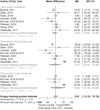Brief Behavioral Treatment for Insomnia: A Meta-Analysis
- PMID: 34632908
- PMCID: PMC8994790
- DOI: 10.1080/15402002.2021.1982715
Brief Behavioral Treatment for Insomnia: A Meta-Analysis
Abstract
Purpose: The current study aims to quantify the effect of brief behavioral treatment for insomnia (BBTI) studies through meta-analysis.
Method: Searches were performed from inception to February 2020, reporting on the effects of BBTI using randomized controlled trials (RCT) (adults aged 32 to 84). The main outcome measures were sleep onset latency (SOL), wake after sleep onset (WASO), sleep efficiency (SE%), and total sleep time (TST).
Results: BBTI showed improved SOL compared with control group in mean difference at early (-15.42 [95% CI: -33.05 to -12.01; I2 =49%]) and late follow-up (-10.52 [95% CI: -1.12 to 0.54; I2=93%]). This was statistically significant at early follow-up, but not at late follow-up. The improvement of WASO by BBTI over the control group was shown at early follow-up (-17.47 [95% CI: -2.67 to 0.45; I2=90%]), and was statistically significant. For WASO, a non-statistically significant improvement of BBTI over the control group was shown at late follow-up (-12.77 [95% CI: -22.47 to -3.08; I2=0%]). SE% was shown improved statistically significant by BBTI over control group at early (4.47 [95% CI: -0.35 to 9.29; I2=98%]) and at late follow-up (6.52 [95% CI: -4.00 to 17.05; I2=89%]). The TST was shown no improvement by BBTI at early follow-up in mean difference (-2.97 [95% CI -38.83 to 32.90; I2=96%]). At late follow-up, TST was shown improvement in BBTI with mean difference (14.52 [95% CI: -31.64 to 60.68; I2=94%]) compared with the control group.
Conclusion: Current evidence suggests that BBTI can be considered preliminarily efficacious and can be used for samples of middle-aged and older adults.
Conflict of interest statement
DECLARATION OF INTEREST STATEMENT
None
Figures





Similar articles
-
Efficacy of brief behavioral treatment for insomnia in older adults: examination of sleep, mood, and cognitive outcomes.Sleep Med. 2018 Nov;51:153-166. doi: 10.1016/j.sleep.2018.05.018. Epub 2018 Jun 2. Sleep Med. 2018. PMID: 30195661 Free PMC article.
-
Efficacy of brief behavioural therapy for insomnia in older adults with chronic insomnia: a systematic review and meta-analysis from randomised trials.Age Ageing. 2023 Jan 8;52(1):afac333. doi: 10.1093/ageing/afac333. Age Ageing. 2023. PMID: 36702516
-
Sleep Discrepancy in a Randomized Controlled Trial of Brief Behavioral Therapy for Chronic Insomnia in Older Adults.Behav Sleep Med. 2021 Mar-Apr;19(2):221-231. doi: 10.1080/15402002.2020.1726750. Epub 2020 Feb 10. Behav Sleep Med. 2021. PMID: 32039635 Free PMC article. Clinical Trial.
-
Effects of a Tailored Brief Behavioral Therapy Application on Insomnia Severity and Social Disabilities Among Workers With Insomnia in Japan: A Randomized Clinical Trial.JAMA Netw Open. 2020 Apr 1;3(4):e202775. doi: 10.1001/jamanetworkopen.2020.2775. JAMA Netw Open. 2020. PMID: 32286659 Free PMC article. Clinical Trial.
-
The effects of acupuncture versus sham/placebo acupuncture for insomnia: A systematic review and meta-analysis of randomized controlled trials.Complement Ther Clin Pract. 2020 Nov;41:101253. doi: 10.1016/j.ctcp.2020.101253. Epub 2020 Nov 1. Complement Ther Clin Pract. 2020. PMID: 33186824
Cited by
-
Beyond continuous positive airway pressure for cardiovascular risk reduction in patients with obstructive sleep apnea.Sleep Adv. 2024 Dec 18;5(1):zpae094. doi: 10.1093/sleepadvances/zpae094. eCollection 2024. Sleep Adv. 2024. PMID: 39758351 Free PMC article.
-
Effectivity of (Personalized) Cognitive Behavioral Therapy for Insomnia in Mental Health Populations and the Elderly: An Overview.J Pers Med. 2022 Jun 29;12(7):1070. doi: 10.3390/jpm12071070. J Pers Med. 2022. PMID: 35887566 Free PMC article. Review.
-
Protocol of Brief Behavioral Treatment for insomnia intervention for adult patients with cancer and their sleep-partner caregivers.Contemp Clin Trials Commun. 2025 Apr 19;45:101486. doi: 10.1016/j.conctc.2025.101486. eCollection 2025 Jun. Contemp Clin Trials Commun. 2025. PMID: 40330582 Free PMC article.
-
Trauma history and persistent poor objective and subjective sleep quality among midlife women.Menopause. 2025 Mar 1;32(3):207-216. doi: 10.1097/GME.0000000000002480. Epub 2025 Feb 21. Menopause. 2025. PMID: 39773930
-
A nurse-delivered intervention to reduce insomnia in cancer survivors: Study protocol for a randomized-controlled trial.Contemp Clin Trials. 2022 Nov;122:106939. doi: 10.1016/j.cct.2022.106939. Epub 2022 Sep 28. Contemp Clin Trials. 2022. PMID: 36182027 Free PMC article.
References
-
- Bootzin RR, Epstein D, & Wood JM (1991). Stimulus control instructions. In Case studies in insomnia (pp. 19–28). Springer, Boston, MA. 10.1007/978-1-4757-9586-8_2 - DOI
-
- Borenstein M, Hedges LV, Higgins JP, & Rothstein HR (2011). Introduction to meta-analysis. John Wiley & Sons.
Publication types
MeSH terms
Grants and funding
LinkOut - more resources
Full Text Sources
Medical
